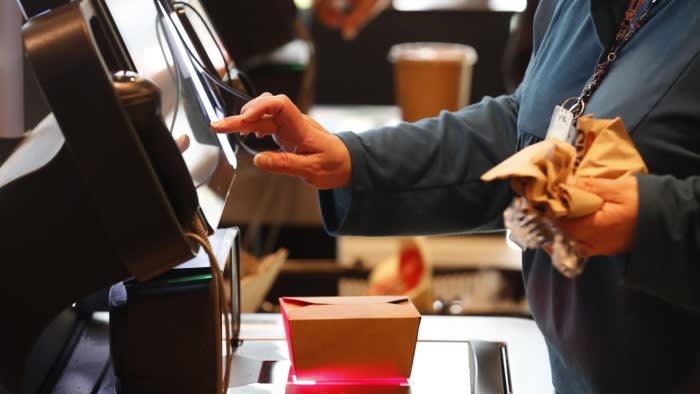Stay informed with free updates
Simply sign up to the Retail sector myFT Digest — delivered directly to your inbox.
The US just suffered through a horrific retail crime wave, or so its big retailers would have us believe.
Starting in late 2022, mentions of theft shot up 80 per cent on earnings calls, according to AlphaSense, and the National Retail Federation warned that “unprecedented” levels of shoplifting had pushed losses to an all-time high of $112bn.
Drugstore chains started locking up stock behind glass doors. CVS brought in security dogs, Target warned theft was a “significant financial headwind” and Rite Aid blamed “brazen shoplifting” for poor financial results. Walgreens cited “organised retail crime” as it shut some San Francisco locations, and other chains adopted similar justifications.
But despite some dramatic footage of smash and grab heists, evidence for a wider problem proved thin. The “unprecedented” 2022 losses added up to 1.6 per cent of total US retail sales, a return to the 2019 average loss rate after a dip in 2021. A separate Council on Criminal Justice study of shoplifting found the number of incidents reported to the police rose in New York, Los Angeles and Dallas and four other US cities between 2019 and 2023, but it fell in 17 other jurisdictions.
The cataclysm also ended quickly. Retail executives have stopped using apocalyptic language and returned to talking about stock losses as “shrink”, as they had done for decades. Target is now expecting its losses from theft to be flat in 2024, Walgreens’ shrink rates have dropped and an executive conceded on a 2023 earnings call that “maybe we cried too much” about crime. Some retail chains are still closing locations — as they were before the pandemic — but they are talking mostly about improving performance and a lot less about crime.
Much of the kerfuffle now appears to be rooted in loose talk from retail executives who needed a scapegoat for falling profit margins, amplified by overheated commentary and politicians eager to look tough on crime.
But to the extent that theft did rise, the experience serves as a cautionary tale about the limits of automation even as a wider range of companies tout the cost-saving potential of artificial intelligence.
Many chain stores that reported unexpected jumps in shrinkage had ramped up use of self-checkout and sensors during the pandemic while reducing employee ranks at tills and on shop floors. Those measures cut labour bills and helped stores navigate post-pandemic worker shortages.
But the empty aisles and unmanned registers proved vulnerable to opportunistic pilfering and criminal gangs who found online marketplaces made it easy to dispose of ill-gotten goods.
Self-checkout has long been associated with higher theft. One 2018 study estimated that when a store shifted half of its transactions to self-checkout, its shoplifting losses would rise by 75 per cent. User surveys bear this out: 21 per cent of self-checkout users told Lending Tree that they have mistakenly failed to pay for an item, and 15 per cent admitted stealing deliberately.
AI hooked up to sensors and overhead cameras can now identify much of the cheating that goes on at checkout and flag up odd behaviour in the aisles that may signal theft. But stores still need people to deal with the miscreants, and the resulting confrontations can be unpleasant or dangerous.
Some retailers have seen the wisdom of reinserting people back into the process. Last month, Dollar General, which runs discount stores, announced plans to remove self-checkout from 300 outlets with large theft problems and to drive more traffic to human cashiers elsewhere. Target has restricted self-checkout to baskets of 10 items or fewer, and Walmart is limiting use of the machines in some stores. “We believe these actions have the potential to have a material and positive impact on shrink,” Dollar General’s chief executive Todd Vasos told analysts.
Chains are also hiring additional greeters, floor walkers and security guards to deter misbehaviour in the first place, while relying on technology to help identify which items and aisles are most in need of supervision.
“Retailers are seeing the need for a multipronged strategy. AI is a part of every box but it is not the same in every box. We are seeing modification and stratification,” says Gerry Hough, a retail expert at McKinsey.
Retailers have discovered the hard way that dealing with the public often requires the human touch. As other industries rush to use AI to cut their labour costs, it is a lesson they should ponder.
Follow Brooke Masters with myFT and on X

Eugen Boglaru is an AI aficionado covering the fascinating and rapidly advancing field of Artificial Intelligence. From machine learning breakthroughs to ethical considerations, Eugen provides readers with a deep dive into the world of AI, demystifying complex concepts and exploring the transformative impact of intelligent technologies.


